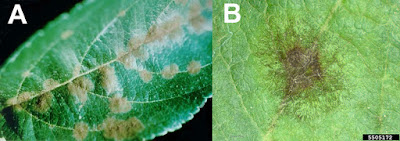Season-long control of apple scab is very difficult if primary apple scab infections develop. Primary scab infections appear with brown puffy like lesions on the top side of the leaf (A) and as mold like lesions on the bottom of a leaf (B).
These primary lesions produce secondary inoculum placing fruit at risk for secondary, conidial infections (Fig. 2). Once the primary ascospores have matured at least 95%, and are possibly depleted, we will have to continue to monitor scab infection events and maintain spray coverage accordingly for at least 14 more days, if not longer, if we we have found primary lesions, to protect from secondary lesions like those in Fig. 2 on McIntosh and any McIntosh hybrids like Cortland and Empire. If you have seen lesions like those in Fig. 1 or Fig. 2, on your trees or on your fruit, then you will now need to protect the rest of your clean from secondary lesions.
 |
| Fig. 2 |
The best product for protecting your fruit is Captan, a contact protectant. And that means that your trees will need to be sprayed with Captan at the full labelled rate prior to any rain event to protect your fruit. If there are no rain events between sprays, a single contact protectant spray will last at least 10 days but not more than 14 days, based on the product's labeled information. You will need to make sure that your trees and fruit are protected prior to any rain event when using only a protectant. But, a protectant can lose its effectivness after 2" of rain, so you also want to reapply as soon as you can before the next rain event. If no protection is available during the wetting event, then the liklihood of your fruit getting infected dramatically increases.
As always, be sure to follow the label directions on any spray product you may use. For further information on control of apple scab, refer to:
http://royaloakfarmorchard.blogspot.com/2021/04/apple-scab-season-has-arrived.html
Reference in this publication to any specific commercial product, process, or service, or the use of any trade, firm, or corporation name is for general informational purposes only and does not constitute an endorsement or certification of any kind by Royal Oak Farm. People using spray products assume responsibility for their use in accordance with current label directions of the manufacturer for that product.







